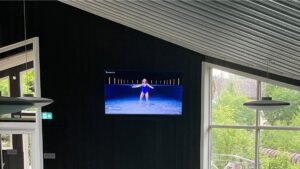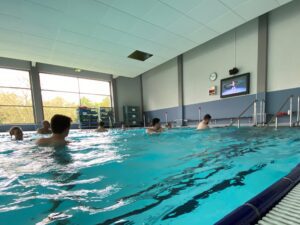In the Liikuntacoach activity aimed at secondary students in the city of Helsinki, Penniina Toikkanen, sports coach/project planner, implemented two beginner swimming courses, one held at Mäkelänrinne swimming hall, and the other at a private pool.
Both of the fall groups consisted of students with immigrant backgrounds, and they hardly spoke any Finnish. The participants’ mother tongues were a diverse combination of different languages, such as Somali, Arabic, and Russian.
Tackling the challenge
The language barrier has traditionally made teaching challenging, but in the fall groups, Hydrohex-produced swimming instruction videos were used to equalize swimming instruction and facilitate the communication of the subject matter to a multilingual group.
In the pool, in addition to the lack of a common language, there are other challenges in showing example performances:
- Water reflects, and it’s difficult to see guidance under the water from the surface.
- The movement performed in the water cannot be shown precisely from land. Water supports and resists movement, so it’s not the same as movement on land.
Swimming instruction videos were also used to ease these challenges.

The target group for the fall Liikuntacoach swimming courses were those without swimming skills or with only a little knowledge of swimming, so the starting level was low. The goal of the courses was to learn basic skills, such as acting safely in water, and beginner swimming skills. During the course, all students achieved these learning goals, and some were swimming long distances independently.
How does Penniina use the videos in teaching?
When Hydrohex was introduced
Custom lesson plans were built for the Liikuntacoach beginner swimming course, based on Liikuntacoach’s own lesson plans. This was important because previously the lesson plans were team-specific and thus always a compromise-like combination of different teaching methods.
Before the class
Penniina prepares for the day’s lesson by going through the day’s lesson plan and lesson framework. She watches the videos and looks for any additional videos that may be needed. Getting to know the material is, according to Penniina, the most important tip for a new user:
“Go through the swimming exercises and lesson frameworks. Familiarize yourself with how the device works, as well as how transitions from one video to another and to individual exercises happen.”
During the lesson
Videos are easy to browse and show the desired exercise from the video. At the beginning of the exercise, the video is watched together several times. During practice, students can then watch the example on the video again.
“Using videos allowed for better instruction from the edge of the pool when a clear example is shown on video. It also didn’t take as much time to describe the exercise being practiced since everyone could see what was being done. It didn’t even matter that the swimming hall is noisy or if one doesn’t fully understand Finnish.”
After the lesson
Previously in summer swim school, course participants were given optional YouTube videos to watch at home. The weakness of these was that the videos showed the whole performance without focusing on, for example, the desired part of the movement.
In Hydrohex, the videos are more segmented, and the videos consist only of the exercises that the swimming instructor wants to use. With Hydrohex, visual guidance was provided during the lesson, not as homework.
Noticeable changes in instruction
Penniina thought that there would be differences between her fall groups, and the videos would work differently for different groups. However, she noticed similar effects in both groups:
- Using videos calmed waiting situations. Course participants watched how the example performance went while waiting. This gave them time to become familiar with the task and to observe smaller details visible in the video.
- Using videos reduced “going solo.” Sometimes when group members are excited or have just learned a new skill, eager trials occur during the lesson, even though the skills are still lacking. Videos reduced the individual swimmers’ risk-taking and led to safer teaching situations, as well as less need for adjustments.
- Even though one swimming hall had a lot of distractions and a more challenging environment, the videos worked well in both places.
Overall, the use of videos equalized learning. Regardless of starting level and language skills, everyone was better able to follow and understand the instruction, which also positively reflected in the learning outcomes.
Equal Opportunities for Swimming Skills
The feedback from course participants was unanimous – the videos facilitated learning. According to comments, it was easy to understand from the videos what should be done in the pool.
Penniina also commented, “The course participants responded very positively to the videos, everyone felt the videos supported learning.”
Similar observations have been made with other swimming instruction groups. In addition, in a multilingual and multicultural group, video materials enable equal learning opportunities for different individuals.
“Hydrohex swimming instruction materials were a big help and support from the first session. It removed the language barrier between me and the course participants.”
Background
The fall 2023 project with the City of Helsinki’s Liikuntacoach was Hydrohex’s first step in the development of adult swimming instruction. This collaboration enabled the first trial of Hydrohex’s swimming instruction materials in teaching non-Finnish-speaking adults.
We found the project’s opportunity to test and develop our materials to the needs of multilingual and multicultural groups particularly meaningful. This experience provided valuable information and guidelines for the further development of the materials, aiming to offer equal learning opportunities to adult learners from different backgrounds.



